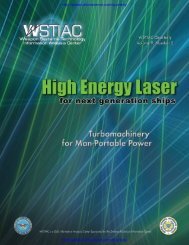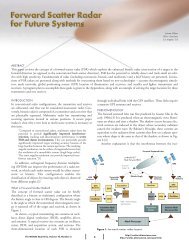Comparing Blast Pressure Variations of Lead Primers - Weapon ...
Comparing Blast Pressure Variations of Lead Primers - Weapon ...
Comparing Blast Pressure Variations of Lead Primers - Weapon ...
You also want an ePaper? Increase the reach of your titles
YUMPU automatically turns print PDFs into web optimized ePapers that Google loves.
ABSTRACT<br />
This article describes the blast pressure waves produced by detonation <strong>of</strong> both lead styphnate and diazodinitrophenol (DDNP) based firearms<br />
primers measured with a high-speed pressure transducer located at the muzzle <strong>of</strong> a rifle (without powder or bullet). These primer blast waves<br />
emerging from the muzzle have a pressure-time pr<strong>of</strong>ile resembling free field blast pressure waves. The lead based primers in this study had<br />
peak blast pressure variations (standard deviations from the mean) <strong>of</strong> 5.0-11.3%. In contrast, lead-free DDNP-based primers had standard<br />
deviations <strong>of</strong> the peak blast pressure <strong>of</strong> 8.2-25.0%. Combined with smaller blast waves, these large variations in peak blast pressure led to<br />
delayed ignition and failure to fire in brief field tests.<br />
INTRODUCTION<br />
Over the past two decades, there has been a growing interest in<br />
removing lead from ammunition due to environmental and health<br />
concerns. For example, the US Army has issued the new M855A1<br />
load with lead-free bullets to troops in Afghanistan. If lead-free bullets<br />
demonstrate field performance equal to their counterparts that<br />
include lead, the only lead needing to remain in duty ammunition<br />
would be lead based centerfire primers. Diazodinitrophenol (2diazo<br />
4,6 dinitrophenol, abbreviated as DDNP and also referred to<br />
as diazole and dinol) is regarded as a promising candidate to replace<br />
lead styphnate in centerfire priming compounds. An Air Force study<br />
showed that transitioning to training ammunition with lead-free<br />
bullets and primers can reduce instructor exposure to lead by 70%<br />
in indoor ranges and 41% in outdoor ranges.[1]<br />
Testing <strong>of</strong> primer performance ultimately requires using ammunition<br />
fully loaded as it would be for a given application. However,<br />
it is also desirable to have a method to test and compare primer performance<br />
independently <strong>of</strong> a given cartridge and load to remove<br />
confounding effects <strong>of</strong> powders, bullets, neck tension, case capacity,<br />
bore friction, etc. so that performance <strong>of</strong> different primer designs<br />
can be compared more directly. The method employed here for<br />
directly comparing primer performance is to measure the blast pressure<br />
wave produced by impact detonation <strong>of</strong> a primer loaded in a<br />
cartridge case without any bullet or powder. In this study, measurements<br />
are presented for eight lead based primers (four large, 5.33<br />
mm diameter, and four small, 4.45 mm diameter), and two DDNPbased<br />
primers (one large and one small).<br />
Peter Griess is credited with discovering diazo compounds in<br />
1858.[2] Over the next 50 years, the chemistry <strong>of</strong> diazo compounds<br />
and their applications were further investigated.[2] US patents for<br />
improved processes for manufacturing DDNP for explosive applications<br />
were awarded in 1922, 1935, and 1946.[3-5] In 1932, a<br />
patent for primer compounds including DDNP was awarded to<br />
agents <strong>of</strong> the Remington Arms Company.[6] In the 1980s, interest<br />
increased in using DDNP as a main component in non-toxic priming<br />
compounds, and since 1985 more than a dozen patents have<br />
been awarded for specific applications to small arms. Hoping to further<br />
reduce toxicity <strong>of</strong> gunshot residues, some <strong>of</strong> these formulations<br />
employ non-toxic oxidizers as well, such as zinc peroxide. Between<br />
The WSTIAC Journal, Volume 11, Number 2 3<br />
http://wstiac.alionscience.com<br />
http://wstiac.alionscience.com/quarterly<br />
Amy C. Courtney<br />
BTG Research<br />
Colorado Springs, CO<br />
Michael W. Courtney<br />
US Air Force Academy<br />
USAF Academy, CO<br />
2000 and 2009, several American ammunition manufacturers<br />
<strong>of</strong>fered at least one product line with lead-free primers, and DDNPbased<br />
primers were being manufactured on a commercial scale at<br />
Muron in Russia.[7]<br />
METHOD<br />
The measurement method was originally described in the Review <strong>of</strong><br />
Scientific Instruments.[8] <strong>Blast</strong> pressures were measured using a highspeed<br />
pressure transducer (PCB 102B or PCB 102B15) placed coaxially<br />
with the 7.82mm diameter rifle barrel and directly facing the<br />
muzzle with no separation between the end <strong>of</strong> the barrel and pressure<br />
transducer. Only a primer is loaded in the brass cartridge case (no bullet<br />
or powder) and detonated by the impact <strong>of</strong> the firing pin.<br />
A cable connects the pressure transducer to a signal conditioning<br />
unit (PCB 842C) that produces a calibrated voltage output, which<br />
is then digitized with a National Instruments PXI-5105 fast analog<br />
to digital converter operating at a rate <strong>of</strong> 1 million samples per second.<br />
The voltage waveform is converted to pressure using the calibration<br />
certificate provided by the manufacturer with each pressure<br />
sensor. Ten samples each <strong>of</strong> eight models <strong>of</strong> widely used lead based<br />
primers were tested along with two DDNP-based primers, a large<br />
rifle primer (model KVB-7E) and a small pistol primer (model<br />
KVB-9E) manufactured in Russia at Muron. Brief field tests were<br />
also conducted comparing two large rifle primers in loaded ammunition<br />
and noting muzzle velocities, accuracy, and ignition delays.<br />
RESULTS<br />
Figure 1 shows blast pressure waveforms <strong>of</strong> four primer types. The<br />
arrows in the figure denote the range <strong>of</strong> peak blast pressures for a<br />
sample size <strong>of</strong> 10. Compared with its average peak blast pressure, the<br />
DDNP-based KVB-7E has a much larger variation in peak blast<br />
pressure than other primers. (Waveforms for different models are<br />
<strong>of</strong>fset in time to facilitate comparison.) Simple blast waves are usually<br />
characterized by peak overpressure, duration, and impulse (the<br />
area under the curve <strong>of</strong> pressure vs. time). Since the durations and<br />
basic shapes are similar, the impulse is nearly proportional to the<br />
peak pressure, and the peak pressure is the main distinguishing characteristic<br />
<strong>of</strong> these blast waves. Therefore, the results and discussion<br />
will focus on the average peak magnitude and the standard deviation<br />
<strong>of</strong> peak magnitudes for each primer type.




